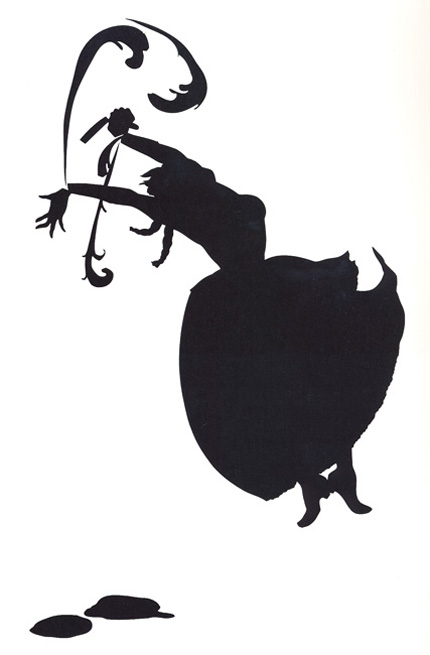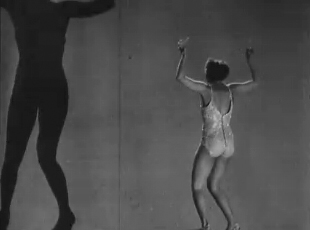|
Daphne Ann Brooks,
"The End of the Line: Josephine Baker and the Politics of Black Women's Corporeal Comedy"
(page 5 of 6)
The Silhouette Artist and the Shadow Dancer
Baker's unpredictable, Topsy-like comedic moves lead us to an
unlikely yet highly provocative twenty-first-century trickster and comic
artist, one who also embraces the pickaninny figure as one of her muses.
This artist is Kara Walker.

Figure 5
Critic Annette Dixon suggests that we consider the comedic elements
of Walker's controversial art. Walker's humor, she argues, "is slapstick
and debasing (evoking that of the minstrel show), yet without it, the
horrific aspects of the scenes would be unbearable."[12] But we might
stop to ask what it is about the space that the silhouette creates that
enables humor. Humor is allowed to ferment and thrive in these darkened
spaces. What makes this possible is that although the silhouette is
historically "tied to the conventions of caricature," Walker has managed
to utilize this form in order to "engage the question of how one
represents race through reduced means. It is through outline and shape,
and the intervals between shapes, that information is conveyed,"
explains Dixon.[13]

Figure 6
Walker lobs ribald and pornographic punch lines through the
exaggerated, grotesque shapes of her forms. Often in profile, her
minstrel figures break out of their straitjacketed shapes in bursts of
startling historical and political malapropisms. Beyond the disobedience
of their pickaninny figurations, though, Walker and Baker have even more
in common if we consider Baker's performance in Zou Zou and her
use of the mobile silhouette—the playful shadow puppets [video] that she deploys
at the end of the film as Zou Zou literally tries her hand at a career
on the stage.

Zou Zou: Shadow Puppets [Back to text]
In Zou Zou, Baker's shadow puppet performance operates as the
critical turning point in the plot. It provides a bridge between Zou
Zou's role as a laboring laundress and her point of entry to the stage
and subsequent stardom. But perhaps even more suggestively, this
climactic scene in the film demonstrates and celebrates Baker's deft use
of her hands. Invoking a whimsical gesture associated with child's play
and innocence, Baker nonetheless reaffirms her sophistication as a
professional comic performer in this mischievous scene. Through the
savvy work of her hands, she conveys her phantasmagoric gifts at making
shapes in shadowed profile and exploits the darkness of her own shadow.
Oscillating, bobbing, and weaving inward and outward in the creation of
multiple and unexpected shapes and images, Baker here defies the visual
reification (and calcification) of her own body. Here the hands of the
shadow puppeteer shift our attention away from the overdetermined,
sexualized body parts of Baker and black womanhood and toward the
virtuosic hands that make both recognizable and nonsensical shapes that
transmogrify and transfigure in the space of the shadow. And it is
Josephine Baker's ability to utilize the nonsensical in her performances
that finally reinforces her alluring comedic gifts.
Page: 1 | 2 | 3 | 4 | 5 | 6
Next page
|